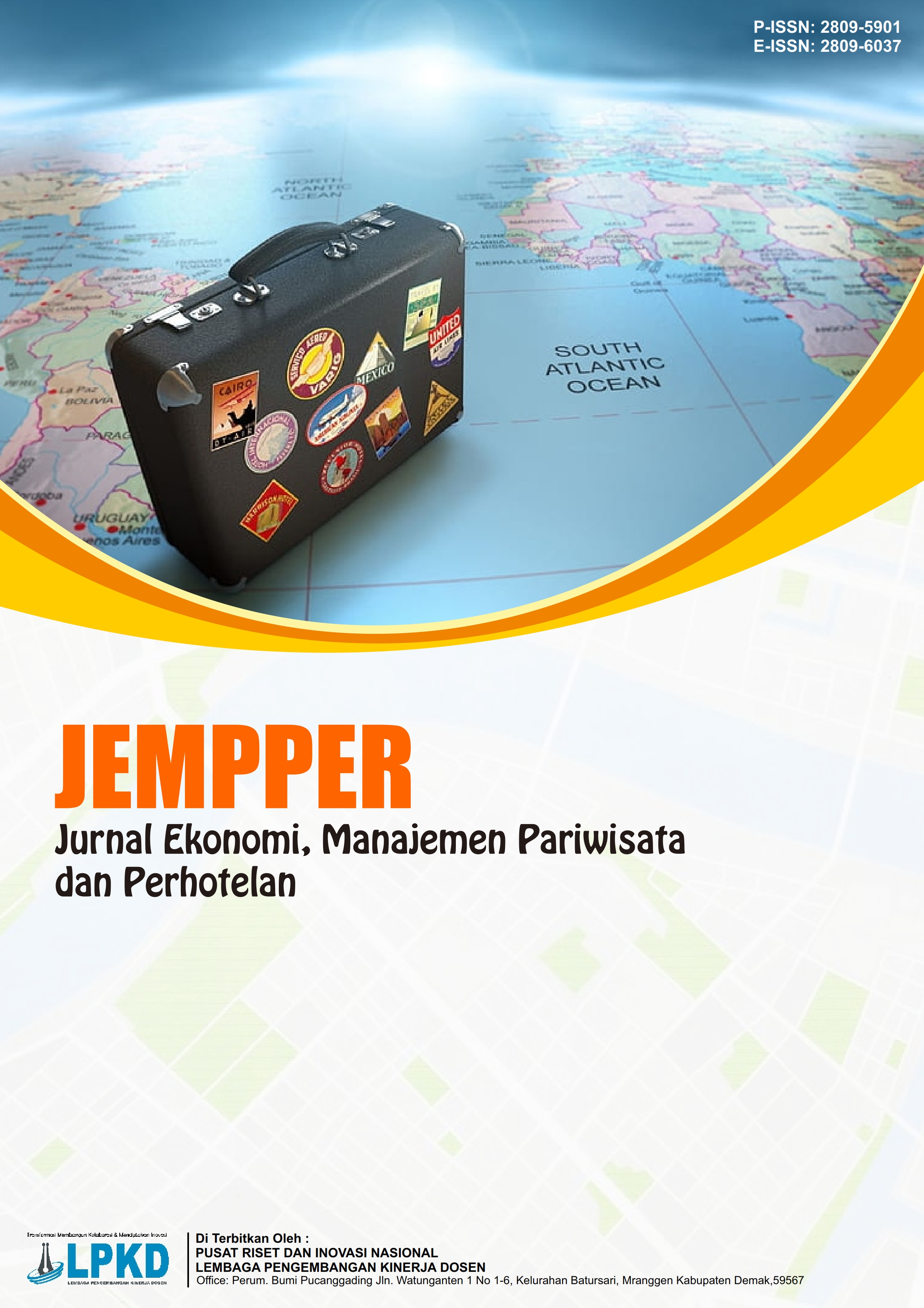Upaya Modernisasi Klepon sebagai Produk Kuliner Tradisional untuk Menyesuaikan dengan Tren Kekinian
DOI:
https://doi.org/10.55606/jempper.v4i3.5195Kata Kunci:
Consumer Preferences, Culinary Creativity, Food Modification, Klepon, ModernizationAbstrak
This study aims to explore the process of transforming traditional Javanese food into modern dishes by adopting a culinary creativity approach and considering today's consumer preferences. One of the dishes that is the main focus of this study is Klepon Lava Cake, an innovation that combines elements of traditional Indonesian food, namely klepon, with a modern dessert concept that is popular among the younger generation. This study seeks to preserve traditional Javanese food in a more attractive, creative, and relevant way, so that it can attract the interest of today's consumers, especially young people who have different tastes and lifestyles than previous generations. Theoretically, this study contributes to the field of gastronomy and culinary innovation by providing new insights into ways that can be applied to develop tradition-based food products to remain relevant in the modern culinary market. Through an understanding of culinary creativity and how to combine local ingredients with modern cooking techniques, this study shows that culinary traditions can adapt without sacrificing their cultural values. Practically, the results of this study can provide benefits for culinary entrepreneurs, especially in designing tradition-based culinary products that have market appeal and can compete in the increasingly growing food industry. By combining traditional and innovative elements, culinary entrepreneurs can create products that not only preserve cultural heritage but also meet the needs and desires of today's consumers. This research shows that creativity in processing traditional foods can be key to introducing Indonesian cuisine to the global market. Furthermore, this study also considers the importance of consumer preferences in creating culinary products that are acceptable to modern society.
Referensi
Alamsyah, M., Angga, V. V., & SS, M. (2023). Wedang Jamu Coro, Nasi Liwet, dan Sidekah Kupat.
Anjarwati, S., Aryani, A. E., Azizah, F. F., & Abdullah, A. A. (2022). Eksplorasi etnomatsains pada lumpia semarang serta implikasi dalam pembelajaran matematika dan sains. PENDIPA Journal of Science Education, 6(1), 183-192. https://doi.org/10.33369/pendipa.6.1.183-192
Bridha, R. L., Priatini, W., & Hamdani, Z. I. (2023). Pengembangan Fusion Food pada Kue Talam Ebi sebagai Modifikasi Makanan Tradisional. Jurnal Gastronomi Indonesia, 11(2), 139-146. https://doi.org/10.52352/jgi.v11i2.1169
Candra, M. A., Enjeladinata, O. V., & Widana, M. R. (2023). Eksistensi makanan tradisional di tengah gempuran makanan Korea. Prosiding Seminar Nasional Ilmu Ilmu Sosial (SNIIS), 2, 352-361.
Hindriari, R., Narimawati, U., Affandi, A., Priadana, S., & Erlangga, H. (2022). Analisis kepemimpinan transformasional dalam meningkatkan kreativitas dan inovasi pada umkm kuliner kabupaten Bekasi. JIIP-Jurnal Ilmiah Ilmu Pendidikan, 5(4), 1127- 1132. https://doi.org/10.54371/jiip.v4i5.535
K. (2024). BISNIS KULINER: Teori dan strategi pengembangan bisnis kuliner. PT. Sonpedia Publishing Indonesia.
Karina, M. S. (2016). Merancang Menu dan Mengembangkan Resep. Materi ASDI. Poltekkes Kemenkes Jakarta II.
Maulana, F. L., Agustini, I. G. A. A., & Kusumaningrum, N. K. V. (2020). Modifikasi Makanan Indonesia Berbahan Santan. Journey: Journal of Tourism Preneurship, Culinary, Hospitality, Convention and Event Management, 3(2), 51-64. https://doi.org/10.46837/journey.v3i2.79
Mellyani, A., & Kusumaningrum, D. A. (2020). Potensi kuliner tradisional khas keraton surakarta, solo, jawa tengah. Jurnal Sains Terapan Pariwisata, 5(3), 302-312.
Namia, Y. Q., Khayati, A. N., & others. (2023). Filosofi Kuliner Tradisional Khas Jawa Sebagai Identitas Nilai Kearifan Lokal Melalui Pembelajaran BIPA. Prosiding Seminar Nasional Dan Internasional HISKI, 3, 486-499.
Nasution, U. B., Yuliasih, M., Judijanto, L., Putra, S. D., Stj, R. C. M. A., & Setiyono,
Parantika, A., & Jenica, G. (2022). Pelestarian dan Pengembangan Makanan Khas Kampung Ciharashas Mulyaharja sebagai Destinasi Wisata Kota Bogor. Journal of Tourism and Economic, 5(1), 63-76. https://doi.org/10.36594/jtec.v5i1.140
Rudiansyah, R., & Sijabat, T. S. (2022). Pengaruh Budaya Tionghoa Terhadap Kuliner Di Kota Medan. Jurnal Cakrawala Mandarin, 6(2), 486-501. https://doi.org/10.36279/apsmi.v6i2.110
Simanullang, L. S. (2023). Kajian Etnobotani dalam Makanan Tradisional Nasi Liwet Khas Sunda di Kecamatan Mustikajaya Bekasi [Ethnobotanical Study in the https://doi.org/10.47349/jbi/19022023/145
Sugiarto, S. R. (2024). Gilo-gilo dalam Karya Sastra: Representasi terhadap Kota Semarang. Lingua Susastra, 5(1), 100-113. https://doi.org/10.24036/ls.v5i1.297
Sunandar, S., Aida, N., & Setyorini, E. E. D. (2023). Diversifikasi sebagai Strategi untuk Meningkatkan Potensi Kue Tradisional Klepon di Kecamatan Gempol Pasuruan. Jurnal Cahaya Mandalika ISSN 2721-4796 (Online), 4(3), 2077-2082.
Traditional Food of Nasi Liwet, Special Sundanese Dish in Mustikajaya District, Bekasi]. Jurnal Biologi Indonesia, 19(2), 145-153.







